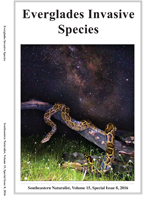Citizen-science programs have the potential to contribute to the management of invasive species, including Python molurus bivittatus (Burmese Python) in Florida. We characterized citizen-science—generated Burmese Python information from Everglades National Park (ENP) to explore how citizen science may be useful in this effort. As an initial step, we compiled and summarized records of Burmese Python observations and removals collected by both professional and citizen scientists in ENP during 2000–2014 and found many patterns of possible significance, including changes in annual observations and in demographic composition after a cold event. These patterns are difficult to confidently interpret because the records lack search-effort information, however, and differences among years may result from differences in search effort. We began collecting search-effort information in 2014 by leveraging an ongoing citizen-science program in ENP. Program participation was generally low, with most authorized participants in 2014 not searching for the snakes at all. We discuss the possible explanations for low participation, especially how the low likelihood of observing pythons weakens incentives to search. The monthly rate of Burmese Python observations for 2014 averaged ∼1 observation for every 8 h of searching, but during several months, the rate was 1 python per >40 h of searching. These low observation-rates are a natural outcome of the snakes' low detectability— few Burmese Pythons are likely to be observed even if many are present. The general inaccessibility of the southern Florida landscape also severely limits the effectiveness of using visual searches to find and remove pythons for the purposes of population control. Instead, and despite the difficulties in incentivizing voluntary participation, the value of citizen-science efforts in the management of the Burmese Python population is in collecting search-effort information.
BioOne.org will be down briefly for maintenance on 17 December 2024 between 18:00-22:00 Pacific Time US. We apologize for any inconvenience.
How to translate text using browser tools
1 December 2016
Prospects and Limitations of Citizen Science in Invasive Species Management: A Case Study with Burmese Pythons in Everglades National Park
Bryan G. Falk,
Ray W. Snow,
Robert N. Reed
ACCESS THE FULL ARTICLE

Southeastern Naturalist
Vol. 15 • No. sp8
December 2016
Vol. 15 • No. sp8
December 2016




